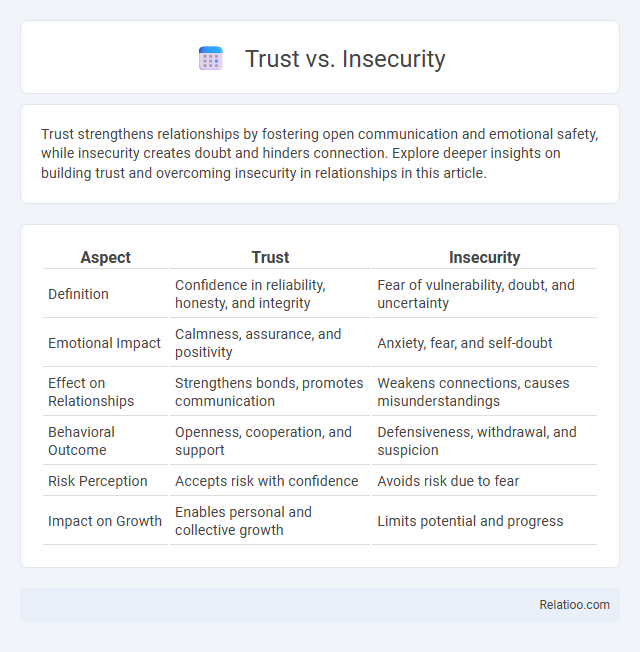Trust strengthens relationships by fostering open communication and emotional safety, while insecurity creates doubt and hinders connection. Explore deeper insights on building trust and overcoming insecurity in relationships in this article.
Table of Comparison
| Aspect | Trust | Insecurity |
|---|---|---|
| Definition | Confidence in reliability, honesty, and integrity | Fear of vulnerability, doubt, and uncertainty |
| Emotional Impact | Calmness, assurance, and positivity | Anxiety, fear, and self-doubt |
| Effect on Relationships | Strengthens bonds, promotes communication | Weakens connections, causes misunderstandings |
| Behavioral Outcome | Openness, cooperation, and support | Defensiveness, withdrawal, and suspicion |
| Risk Perception | Accepts risk with confidence | Avoids risk due to fear |
| Impact on Growth | Enables personal and collective growth | Limits potential and progress |
Understanding Trust: Definition and Importance
Trust is the confident belief in the reliability, truth, and ability of a person or system, essential for building strong relationships and fostering collaboration. Understanding trust involves recognizing its role in reducing uncertainty and enabling effective communication and cooperation. The importance of trust lies in its capacity to create a secure environment where individuals feel valued and confidently engage with others, mitigating insecurity and promoting emotional well-being.
What Fuels Insecurity? Key Psychological Triggers
Insecurity is primarily fueled by low self-esteem, fear of rejection, and past traumatic experiences that challenge an individual's sense of self-worth. Cognitive distortions such as overgeneralization and catastrophizing amplify feelings of vulnerability, leading to chronic anxiety and distrust. Environmental factors like inconsistent relationships and social comparison also act as powerful psychological triggers, intensifying insecurity.
The Role of Communication in Building Trust
Effective communication plays a critical role in building trust by fostering transparency and understanding between parties. When you clearly express your intentions and actively listen to others, it reduces insecurities caused by misunderstandings and assumptions. Consistent, honest dialogue creates a foundation where trust can flourish, minimizing doubts and enhancing relationship security.
How Insecurity Sabotages Relationships
Insecurity generates self-doubt and fear of rejection, which undermines trust and fosters constant suspicion in relationships. This emotional turbulence causes partners to misinterpret intentions and respond defensively, escalating conflicts and weakening bonds. Persistent insecurity disrupts open communication and emotional intimacy, ultimately sabotaging the foundation of healthy, trusting relationships.
Signs You Struggle with Trust or Insecurity
Persistent doubt about others' intentions, constant need for reassurance, and difficulty forming close relationships are key signs of struggling with trust or insecurity. Frequent overthinking, fear of abandonment, and sensitivity to criticism also indicate underlying trust issues. Recognizing these symptoms is crucial for addressing emotional barriers and fostering healthier connections.
The Impact of Past Experiences on Trust Issues
Past experiences profoundly shape an individual's ability to trust, with negative encounters such as betrayal or neglect often leading to deep-seated insecurity and heightened mistrust. These unresolved emotional wounds create cognitive patterns that reinforce fear and doubt, making it difficult to establish healthy relationships. Understanding the psychological mechanisms behind trust issues reveals how trauma disrupts attachment systems and triggers defensive behaviors aimed at self-protection.
Building Trust: Effective Strategies for Individuals and Couples
Building trust requires consistent honesty, open communication, and demonstrated reliability to counteract feelings of insecurity. You can foster deeper connections by actively listening, showing empathy, and maintaining transparency in your actions and intentions. Prioritizing these strategies strengthens emotional bonds and reduces the impact of mistrust in both individual and couple relationships.
Overcoming Insecurity: Practical Steps for Personal Growth
Overcoming insecurity involves recognizing and challenging negative self-beliefs that hinder your confidence and well-being. Practical steps include setting realistic goals, practicing self-compassion, and seeking supportive relationships or professional guidance to reinforce your self-worth. By consistently applying these strategies, you can transform insecurity into trust, fostering personal growth and resilience.
Trust vs Insecurity in the Workplace
Trust in the workplace fosters collaboration, boosts employee morale, and enhances productivity by creating a safe environment for open communication. Insecurity, often stemming from unclear expectations or lack of recognition, undermines confidence and can lead to reduced engagement and increased turnover. You can build a resilient team by promoting transparency, valuing contributions, and consistently supporting your employees' growth.
Choosing Trust: Long-Term Benefits for Mental Health
Choosing trust over insecurity fosters stronger relationships and enhances emotional stability, which are critical for long-term mental health. Trust reduces anxiety and stress by creating a sense of safety and predictability in social interactions. Sustained trust promotes resilience, improves self-esteem, and supports overall psychological well-being.

Infographic: Trust vs Insecurity
 relatioo.com
relatioo.com